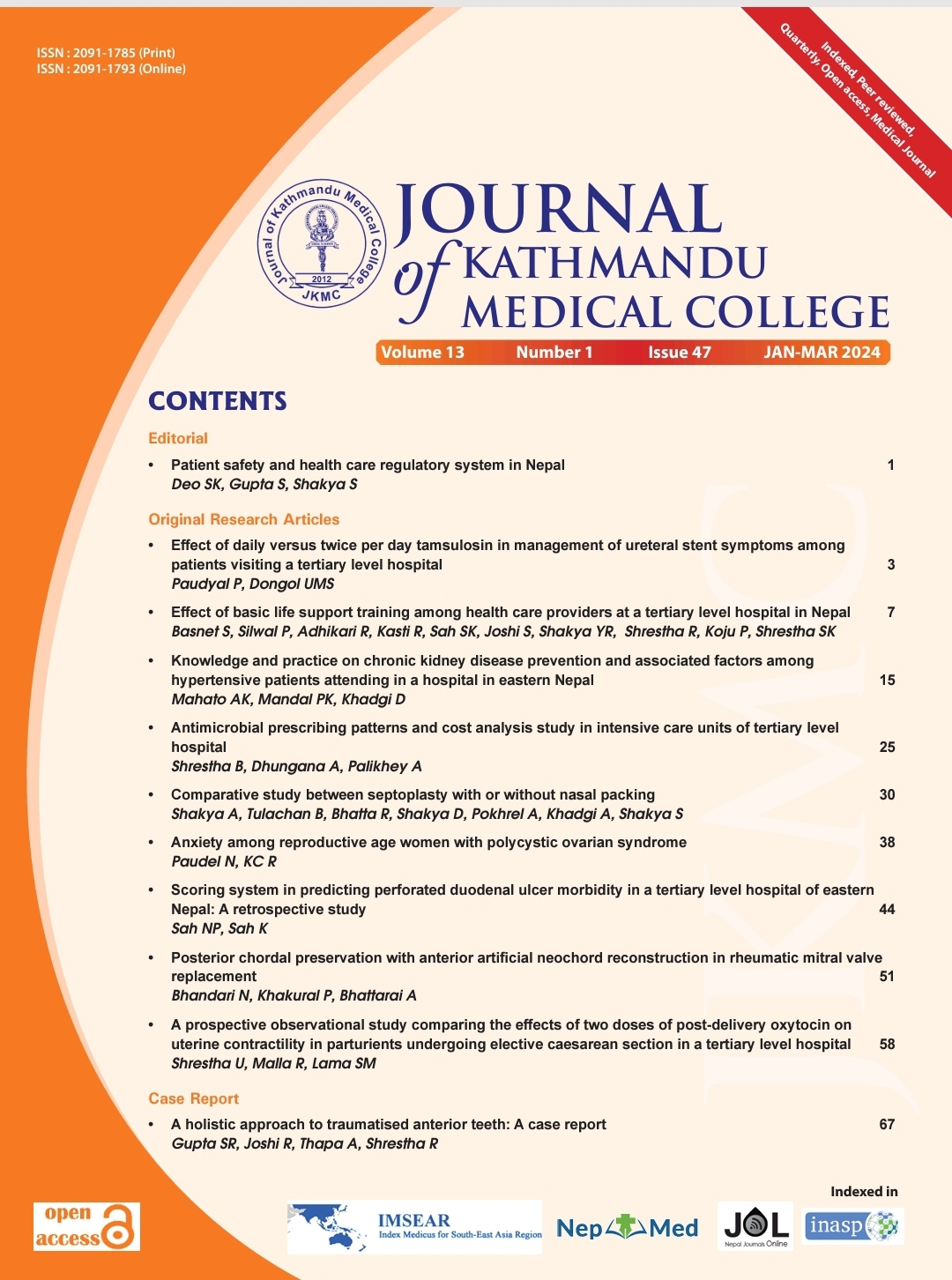Abstract
Introduction: Polycystic ovarian syndrome is a most common endocrine disorder commonly seen in young reproductive age women and is commonly manifested by presence of multiple signs and symptoms like oligomenorrhoea, hirsutism, obesity, and emotional disturbances. These symptoms are frequently linked with decline in women’s self-esteem and self-image and may have psychological problems like anxiety and depression.
Objective: To assess the level of anxiety among reproductive age women with polycystic ovarian syndrome.
Methodology: A descriptive cross-sectional study was conducted among 169 reproductive age women having polycystic ovarian syndrome. Women were selected purposively from polycystic ovarian syndrome WARRIOR Nepali women group. They were approached through Facebook social media. Data were collected through self-administered questionnaire from 2022 October to 2022 November by using Google Forms. SPSS v.21 was used to analyse the data. Both descriptive and inferential statistics were used.
Result: Out of 169, more than two third (115, 68%) women had moderate to severe level of anxiety, and 54 (32%) had minimal to mild level of anxiety. Level of anxiety was significantly associated with education, duration of diagnosis of polycystic ovarian syndrome, presence of acne, and thickened dark patches on the skin of women.
Conclusion: Overall, anxiety was highly prevalent among reproductive age women with polycystic ovarian syndrome. Early detection and prompt treatment of polycystic ovarian syndrome is required to reduce the level of anxiety among women.
References
Azziz R, Carmina E, Dewailly D, et al. The androgen excess and PCOS society criteria for the polycystic ovary syndrome: The complete task force report. Fertil Steril. 2009;91:456-88. [PubMed | Full Text | DOI]
Solorzano CB, Ehrmann D, Azziz R. Polycystic ovary syndrome | Endocrine society. Endocrine.org, Endocrine Society, 24 January 2022. [Full Text]
Singh A, Vijaya K, Laxmi KS. Prevalence of polycystic ovarian syndrome among adolescent girls: A prospective study. Int J Reprod Contraception Obstet Gynaecol. 2018 Oct 25;7(11):4375-8. [Full Text | DOI]
Wu Q, Gao J, Bai D, et al. The prevalence of polycystic ovarian syndrome in Chinese women: A meta-analysis. Ann Palliat Med. 2021 Jan;10(1):74-87. [PubMed | Full Text | DOI]
Kc S, Shah RK, Singh A, et al. Prevalence of polycystic ovarian syndrome among medical students of a tertiary care hospital. JNMA J Nepal Med Assoc. 2020 May 30;58(225):297-300. [PubMed | Full Text | DOI]
World Health Organisation: Polycystic ovarian syndrome WHO. June 2023. [Full Text]
Cooney LG, Lee I, Sammel MD, et al. High prevalence of moderate and severe depressive and anxiety symptoms in polycystic ovary syndrome: A systematic review and meta-analysis. Hum Reprod. 2017 May 1;32(5):1075-91. [PubMed | Full Text | DOI]
Harnod T, Tsai IJ, Wang JH, et al. Women with polycystic ovary syndrome associated with increased anxiety risk: A population-based cohort study in Taiwan. J Affect Disord. 2020 Aug 1, 31;273:532-7. [PubMed | Full Text | DOI]
Beck AT, Epstein N, Brown G, et al. An inventory for measuring clinical anxiety: Psychometric properties. J Consult Clin Psychol. 1988;56(6):893-7. [PubMed | Full Text | DOI]
Kohrt BA, Kunz RD, Koirala NR, et al. Validation of the Nepali version of the beck anxiety inventory. Journal of Institute of Medicine. 2003;1-4. [Full Text]
Bharali MD, Rajendran R, Goswami J, et al. Prevalence of polycystic ovarian syndrome in India: A systematic review and meta-analysis. Cureus. 2022 Dec 9;14(12):e32351. [PubMed | Full Text | DOI]
Joshi AM, Yonzon P, Tandukar S. Clinical profile of patients with polycystic ovarian syndrome in Nepal. Endocrinology and Metabolism International Journal. 2017;4(2):50-2. [Full Text | DOI]
Pandey MR. Clinical profile of PCOS patients at a tertiary care center in Gandaki Province of Nepal. Asian J Med Sci. 2020;11(5):35-7. [Full Text | DOI]]
Chaudhari AP, Mazumdar K, Mehta PD. Anxiety, depression, and quality of life in women with polycystic ovarian syndrome. Indian J Psychol Med. 2018 May 1;40(3):239-46. [PubMed | Full Text | DOI]
Sangabathula H, Varaganti N. Clinical profile polycystic ovarian syndrome-100 cases. Journal of Contemporary Medical Research. 2017;4(6):1249-53. [Full Text]
Blay SL, Aguiar JVA, Passos IC. Polycystic ovary syndrome and mental disorders: A systematic review and exploratory meta-analysis. Neuropsychiatr Dis Treat. 2016 Nov 8;12:2895-903. [PubMed | Full Text | DOI]
Dybciak P, Humeniuk E, Raczkiewicz D, et al. Anxiety and depression in women with polycystic ovary syndrome. Medicina (Kaunas). 2022 Jul 16;58(7):942. [PubMed | Full Text | DOI]
Teede HJ, Misso ML, Costello MF, et al. Recommendations from the international evidence-based guideline for the assessment and management of polycystic ovary syndrome. Fertil Steril. 2018 Aug 1;110(3):364-79. [PubMed | Full Text | DOI]
Khan AYR, Abdullah MA, Gul R, et al. Prevalence of anxiety and depression among women with polycystic ovarian syndrome: A cross-sectional study from a tertiary care hospital of Islamabad, Pakistan. Cureus. 2024 Jan 19;16(1):e52540. [PubMed | Full Text | DOI]
Molla A, Alrizqi H, Alharbi E, et al. Assessment of anxiety and depression in patients with acne vulgaris in Medina: A case-control study. Clin Cosmet Investig Dermatol. 2021 Aug 6; 14:999-1007. [PubMed | Full Text | DOI]

